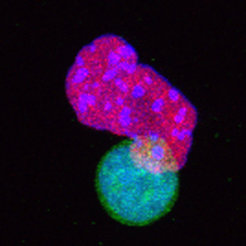From pluripotency to totipotency
Scientists discover mechanism that may lead to more efficient reprogramming of somatic cells
While it is already possible to obtain in vitro pluripotent cells (i.e., cells capable of generating all tissues of an embryo) from any cell type, a team of researchers around Maria-Elena Torres-Padilla (Institute of Genetics and Molecular and Cellular Biology, Strasbourg) and Juanma Vaquerizas (Max Planck Institute for Molecular Biomedicine, Münster) have pushed the limits of science even further. They managed to obtain totipotent cells with the same characteristics as those of the earliest embryonic stages and with even more interesting properties (Nature Structural & Molecular Biology, online first August 3rd, 2015; doi:10.1038/nsmb.3066).

Totipotency vs pluripotency
Just after fertilization, when the embryo is comprised of only 1 or 2 cells, cells are "totipotent", that is to say, capable of producing an entire embryo as well as the placenta and umbilical cord that accompany it. During the subsequent rounds of cell division, cells rapidly lose this plasticity and become “pluripotent”. At the blastocyst stage (about thirty cells), the so-called “embryonic stem cells” can differentiate into any tissue, although they alone cannot give birth to a foetus anymore. Pluripotent cells then continue to specialise and form the various tissues of the body through a process called cellular differentiation.
For some years, it has been possible to re-programme differentiated cells into pluripotent ones, but not into totipotent cells. Now, the team of Maria-Elena Torres-Padilla has studied the characteristics of totipotent cells of the embryo and found factors capable of inducing a totipotent-like state. “Totipotency is a much more flexible state than the pluripotent state and its potential applications are extraordinary”, says Maria-Elena Torres-Padilla, who led the study.
Looking for the keys of totipotency
When culturing pluripotent stem cells in vitro, a small amount of totipotent cells appear spontaneously; these are called “2C-like cells” (named after their resemblance to the 2-cell stage embryo). The researchers compared these cells to those present in early embryos in order to find their common characteristics and those that make them different from pluripotent cells. In particular, the teams found that the DNA was less condensed in totipotent cells and that the amount of the protein complex CAF1 was diminished. A closer look revealed that CAF1 -already known for its role in the assembly of chromatin (the organised state of DNA)- is responsible for maintaining the pluripotent state by ensuring that the DNA is wrapped around histones. Based on this hypothesis, the Torres-Padilla team were able to induce a totipotent state by inactivating the expression of the CAF1 complex, which led to chromatin reprogramming into a less condensed state.
In order to carefully examine at a molecular level the similarities between 2-cell stage embryos, 2C-like cells and those induced by inactivating the CAF1 complex, the Torres-Padilla team then joined forces with the Vaquerizas laboratory to analyse, in a genome-wide fashion, the gene expression programmes of these cells. The scientists found that the induced, CAF1-depleted, totipotent cells overexpressed a significant amount of 2-cell stage embryo genes. “One could imagine that if cells lose their ability to assemble chromatin, this would affect gene expression”, explains Cells-in-Motion PhD student Rocio Enriquez-Gasca of Juanma Vaquerizas’ lab, who performed the computational analyses of the work. “So it was really exciting to realise that the resulting gene expression programme in fact significantly overlaps with that of early embryo, totipotent cells”.
Moreover, the teams found that specific classes of repetitive elements (repeated sequences of DNA that form around 50% of the mouse and human genomes) were also up-regulated in induced totipotent-like cells, a hallmark of the 2-cell embryo. “The computational analysis of expression of repetitive elements is very challenging, since these are found many times in the genome”, says Juanma Vaquerizas. “Now it is key to understand why these repetitive elements and gene expression programmes are both up-regulated in totipotent cells”. The work results as a collaboration between the two laboratories in the framework of the RISE1 programme of the EpiGeneSys EU Network of Excellence.
These results provide new elements for the understanding of pluripotency and could increase the efficiency of reprogramming somatic cells to be used for applications in regenerative medicine.



